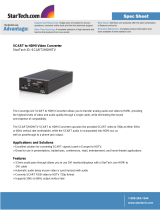
12
Shutting down the projector
Power Save
The projector also has a Power Save feature that automatically turns the
lamp off after no active sources are detected and no user interaction with
the projector is performed for 20 minutes. By default, this feature is on. See
page 26.
Sleep Timer
The projector also has a sleep timer feature that automatically turns the pro-
jector off after 4 hours. See page 26.
Turning off the projector
Press the Power button on the remote or keypad to turn the projector off.
The lamp turns off and the LED blinks green for one (1) minute while the
fans continue to run to cool the lamp. While the LED is blinking green, the
projector does not accept any user input. Once the cooling process is com
-
plete, the LED lights solid green and you can turn the projector back on, if
desired.
NOTE: Once the projector has been turned off, you must wait for one (1)
minute before turning the projector on again. This allows the lamp to prop-
erly cool. The LED lights solid green when the cooling process is complete.
Troubleshooting your setup
If your image appears correctly on the screen, skip to the next section. If it
does not, troubleshoot the setup.
The LED on top of the projector indicates the state of the projector and can
help you troubleshoot.
The following tables show common problems. In some cases, more than one
possible solution is provided. Try the solutions in the order they are pre-
sented. When the problem is solved, you can skip the additional solutions.
Table 3: LED behavior and meaning
LED color/behavior Meaning
solid green The power button has been pressed and
the software has initialized or the projec
-
tor has been powered off.
blinking green The power button has been pressed and
the software is initializing, or the projec
-
tor is powering down and the fans are
running to cool the lamp.
blinking red
see page 32 for more information
A fan or lamp failure has occurred. Make
sure the vents aren’t blocked (see
page 16). Turn off the projector and wait
one minute, then turn the projector on
again. If the projector has exceeded its
lamp life (
page 29), replace the lamp and
reset the lamp timer. Contact Technical
Support if the problem persists
.
solid red An unidentifiable error: please contact
Technical Support.




















